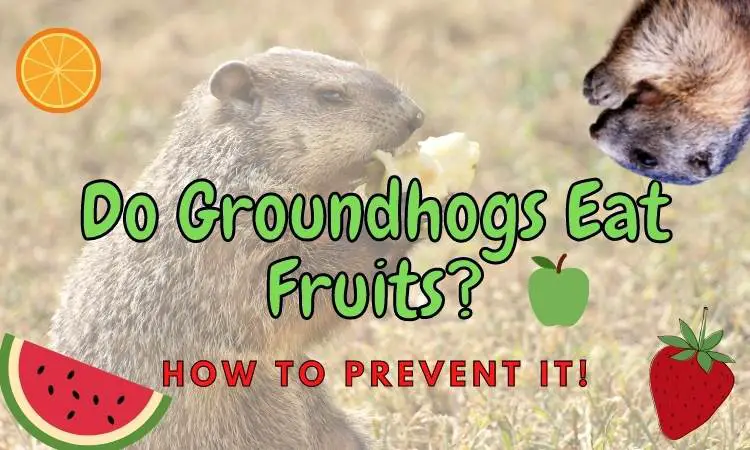Groundhogs (Marmota monax), also known as woodchucks, are omnivores rodents that like to live in burrows they dig.
They eat plants as they are herbivores during the day and sleep on their burrow excavated at night. Groundhogs hibernate for several months every year; they rouse themselves only once or twice to eat, drink and defecate.
In the summer and autumn, they eat many kinds of fruits, roots, onions, zucchini, nuts, numerous flowers, and leaves from trees.
Tasty fruits are very appealing to them, and even though many fruits are high in sugar, they are still highly nutritious to groundhogs all around.
Their natural diet is limited somewhat in fruit choices, but their adaptation to an urban lifestyle among humans have given them access to all types of fruits which has expanded their diet considerably!
Contents
Fruits And The Groundhog Diet
I love watching groundhogs in my backyard, but I’ve always been curious about what they eat.
From observing their foraging habits, I’ve noticed that they have a varied diet that changes with the seasons.
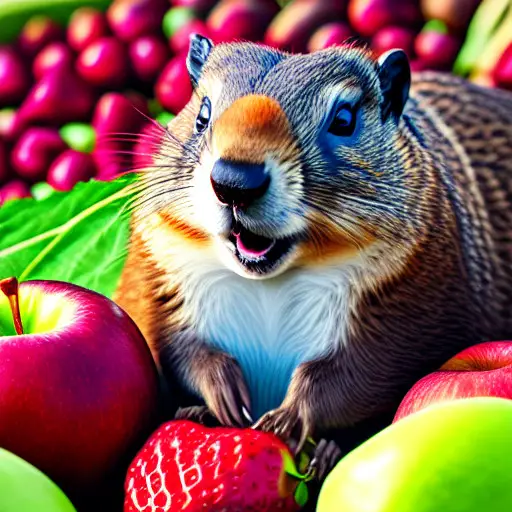
During the summer months, groundhogs enjoy feasting on fresh fruits and vegetables, and as autumn approaches, they switch to nuts and seeds.
While their diet mostly consists of grasses, weeds, and clover, they also have a sweet tooth for fruits. Here are 10 fruits that groundhogs are most likely to eat in a backyard and when and why they might eat them:
Their seasonal eating patterns are not just based on personal preference; it also has an impact on their environment.
By consuming fruits such as berries and melons during the warm months, groundhogs help disperse seeds throughout their habitat.
This helps promote healthy plant growth and diversity in the area.
Additionally, their pest control habits can be beneficial for gardeners as they consume insects that may otherwise damage plants.
Overall, these furry little creatures play an important role in maintaining a healthy ecosystem.
Nutritional Benefits Of Fruits For Groundhogs
As a backyard owner, I always try to make sure that the wildlife around my property is well-fed and healthy. Groundhogs are no exception, and it’s important to know what kind of fruits are good for them. These little critters have unique foraging habits and predator avoidance techniques, so providing them with the right nutrition can help keep them strong and safe.
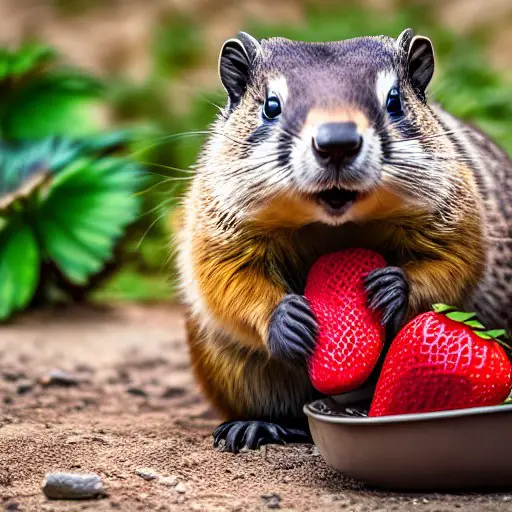
Firstly, it’s important to note that groundhogs love fruit! They’re especially fond of berries like strawberries, raspberries, and blackberries. These fruits provide a great source of vitamins and antioxidants that can help improve their overall health.
Additionally, groundhogs enjoy other fruits like apples, pears, and watermelon. These fruits are high in fiber which can aid in digestion and help prevent common health issues like constipation.
When considering what fruits to feed your groundhog, it’s important to keep in mind seasonal availability. Some fruits may not be available year-round, so it’s best to offer a variety throughout the year.
It’s also worth noting that some fruits may attract garden pests like squirrels or raccoons. To avoid this issue, try placing the fruit on a raised platform or feeding station.
Here are five fruits that groundhogs love:
In addition to being delicious treats for these furry friends, these fruits provide many health benefits including improved digestion and increased immunity against common illnesses.
By incorporating these fruits into their diet you’ll be helping to ensure they stay healthy all year round without compromising their natural instincts or predator avoidance techniques.
Overall, providing your groundhog with a variety of fresh fruit is an easy way to improve their overall health and wellbeing while also keeping them happy and satisfied in your backyard habitat. So next time you’re out picking fruit from your garden or local farmer’s market, consider sharing some with your friendly neighborhood groundhog!
When Do Groundhogs Eat Fruits?
As a backyard owner, I’ve noticed that groundhogs have quite the appetite for fruits. However, their foraging habits depend on the seasonal availability of various fruits.
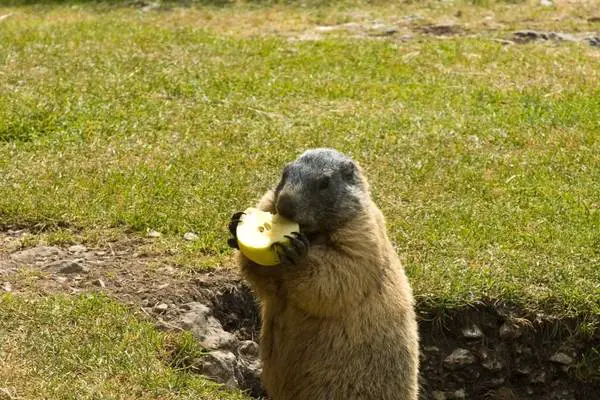
In the summer months, groundhogs tend to feast on juicy watermelons and ripe peaches, while in the fall they prefer apples and pears.
It’s important to note that groundhogs will eat both wild and cultivated fruits. They have a diverse diet variety and aren’t picky eaters.
Unfortunately, their love for sweet treats can make them an easy target for natural predators like foxes and coyotes who are also attracted to fruit trees. As a result, it’s essential to keep a watchful eye on any groundhog activity in your backyard orchard.
In conclusion, if you’re planning on growing fruit trees in your backyard or if you already own an orchard, be prepared to share some of your bounty with these furry critters. Groundhogs’ seasonal preferences may vary on what fruits they eat but one thing is certain- they enjoy all types of fruit trees!
Fruits that Groundhogs Tend to Avoid
As a backyard owner, I’m always looking for ways to control groundhog populations without harming them. And while I’ve learned about their food preferences and digestive issues from my previous research, I’ve also been curious about the foods groundhogs avoid.
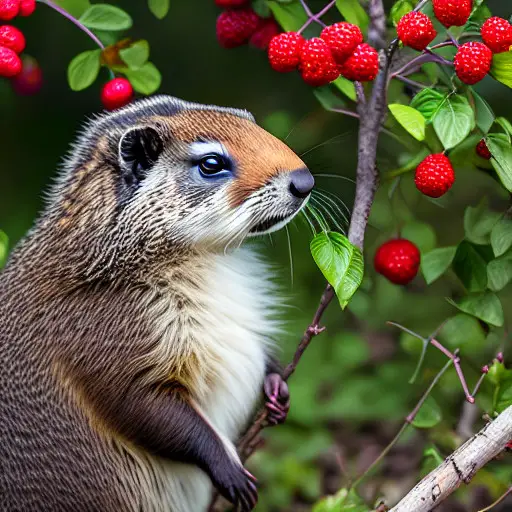
Groundhogs tend to avoid very acidic fruits or fruits that grow in trees where they cant reach them easily such as:
- Pineapple: Groundhogs are unlikely to eat pineapples because they are tropical fruits that are not commonly found in their natural habitat. Additionally, the tough exterior and spiky top make it difficult for groundhogs to access the sweet flesh inside.
- Lemon: Groundhogs are unlikely to eat lemons due to their high acidity, which makes them unappealing to many animals, including rodents like groundhogs.
- Lime: Similar to lemons, groundhogs are unlikely to eat limes due to their high acidity.
- Grapefruit: Groundhogs are unlikely to eat grapefruit due to their bitter taste, which is caused by compounds known as limonoids.
- Avocado: Groundhogs are unlikely to eat avocados because the fruit’s high fat content can cause digestive problems for them.
- Cranberries: Groundhogs are unlikely to eat cranberries due to their tart taste, which is not favored by many animals.
- Blackberries/Raspberries: Groundhogs are unlikely to eat blackberries or raspberries because the bushes they grow on are typically dense and have thorns making it difficult for groundhogs to access the fruit.
- Pomegranate: Groundhogs are unlikely to eat pomegranates because the fruit’s tough exterior and seeds are difficult for them to navigate.
- Kiwi: Groundhogs are unlikely to eat kiwis because they are also tropical fruits that are not commonly found in their natural habitat.
- Mango: Groundhogs are unlikely to eat mangoes because the fruit’s tough exterior and large pit make it difficult for them to access the sweet flesh inside. Additionally, mangoes are also tropical fruits that are not commonly found in their natural habitat.
After all, knowing what they won’t eat can be helpful when it comes to protecting my garden and keeping them away from areas that could potentially harm them.
From what I’ve gathered based on their habitat preferences and lifespan, groundhogs tend to avoid certain types of plants such as ferns, daffodils, and tulips.
These plants are toxic to them and can cause health problems if consumed in large quantities. So while groundhogs may have a wide-ranging diet, it’s important to be aware of the foods they avoid in order to keep both them and your garden safe.
How to prevent groundhogs from eating your fruit:
Because groundhogs are more likely to attract other animals than repel them, you might want to keep groundhogs away from your yard.
The methods I will go through here will not only keep groundhogs away but also most other rodents or larger pest animals.
Instead of trying to kill groundhogs, I would strongly recommend one of the solutions listed below. They are both effective, cheap, and humane as they just scare away the groundhogs rather than harming them.
1. Motion-activated sprinklers
Like most animals, groundhogs hate surprises, and they will run away if suddenly sprayed with water. I like this solution because it is humane, simple, effective, and does not require much time to set up and there are many models to choose from.
My favorite sprinkler option here is the Havahart 5277.
The Havahart 5277 is a motion-activated sprinkler that is activated by the movement of animals up to 25 feet away and sprays them with a harmless water jet, frightening them off and keeping them at bay.
The included metal stake makes it easy to install in your backyard, and the sprinkler can be rotated 180 degrees for maximum coverage.
2. Ultrasonic Sound Emitters
Groundhogs and groundhogs, as well as other animals that may invade your garden, tend to have very good hearing. This means that loud or consistent noises will scare them away or at least shorten their visits significantly!
One of my favorite technologies to keep pests away from my backyard is these cool solar-powered ultrasonic sound emitters that you can buy right off Amazon! In my experience, they really work, and the solar panels on top save you the time and money of changing batteries all the time.
3. Using Lights and Reflections
Groundhogs are nocturnal animals so they may avoid areas that have bright lights. Motion-activated lights, sounds, and sprinklers may help prevent groundhogs from entering your yard.
Placing CDs or tin foil and mirrors around your yard is another cheap and effective way to create light reflections that blind and scare groundhogs.
This may sound a little old-fashioned but it still works! The reflective surface of CDs or tin foil drives groundhogs crazy and will make them seek away from your plants.
You can use old CDs you no longer need or aluminum trays from takeaway containers, just make sure they reflect light well.
If you have a lot of plants to protect this way, it may be a good idea to invest in some commercial mirrors or electronic light emitters like the ones shown above.
4. Build a Fence
The most obvious and practical solution to protecting your plants from groundhogs is to install a fence around the patch. A fence should be at least 2 feet tall and sunk in the ground about 8 inches.
The best fencing material for this purpose is a cattle panel or hog panel as they are very sturdy and can withstand even quadruped animals such as goats, cows, and deer. However, most chicken fencing types will do. This will be strong enough to stop them from getting through while still allowing for airflow and sunlight.
If you don’t like the idea of building a fence around your entire onion patch then you can try fencing off only the area that your onions, tomatoes, or zucchinis are in; this will at least keep some of the groundhogs or groundhogs away from them.
5. Using Hot Pepper Or Garlic Spray
This is a good way to protect your vegetable plants or decorative flowers against pests such as groundhogs, rabbits, deer, and groundhogs. It will also protect your backyard against the neighbor’s cat that thinks it is fine to use your vegetable garden as a toilet.
You only need about 1 tablespoon of crushed chili pepper and garlic along with 1 cup of vinegar per half a gallon of water.
Spray this mixture on any exposed parts of the plant until completely covered. Make sure you reapply whenever rain washes away the spray.
6. Use Rodent Deterring Companion Plants
Instead of making a tincture out of strongly smelling plants, you can also just plant the plants themselves!
Companion planting is a good way of deterring animals like groundhogs from your garden. You can plant strong-smelling plants such as garlic, basil, lavender, and chives around your favorite vegetables.
These plants will keep rodents like groundhogs, groundhogs, and mice away because they don’t like the smell of these and they mask the smell of the delicious plants.
7. Using Artificial Repellent
You can use some of the commercially available repellents to protect your vegetable plants against groundhogs, groundhogs, and other rodents. You will need to be careful when using these though because some of them can end up harming you and your pets if not applied properly. Some of the commercial groundhog repellents available include Shake-Away, Bonide Repels All, Critter Ridder, and Tom Cate Repellent.
8. Using a Scarecrow
Scarecrows may look a little funny in your garden, but they work surprisingly well. Just make sure your scarecrow is big and scary enough to deter groundhogs from getting anywhere near your tomatoes, zucchini, or backyard flowers! Also, you may need to replace the scarecrow every now and then as groundhogs will get used to it.
9. Using live traps
Using live traps to catch the groundhog and drive it away to somewhere safe, but far away, is perhaps the best option if you want to get completely rid of groundhogs in your yard!
You can make a trap yourself with some wire and ingenuity…
But, you can also just buy a live trap, as the sturdy metal ones shown here:
FAQs on Groundhog Fruit Eating Habits
How Do Groundhogs Find And Select The Fruits They Eat?
As a backyard owner, I’ve always been fascinated by the foraging habits of groundhogs. They have their own seasonal preferences when it comes to the fruits they eat, and it’s interesting to watch them select one over the other.
But what I’m most concerned about is their nutritional benefits and digestive issues associated with their food choices. Depending on the food availability in my garden, these critters can be seen nibbling on apples, strawberries, or even tomatoes. However, some fruits may not sit well with their digestive system and cause discomfort.
Understanding their eating habits has helped me create a better environment for both my crops and these furry creatures.
Do Groundhogs Eat Watermelon?
In the late summer and early fall, when melons are ripe, there is a risk that groundhogs will intrude and taste your watermelon produce!
Groundhogs eat watermelon by stripping the fruit from its vines and eating it. They also suck the juice out of fruits. They like watermelons because they grow from the ground, so it is easy for them to take a bite.
Do Groundhogs Eat Cantaloupe?
Groundhogs eat cantaloupes by ripping them from their vines and eating the flesh. They tend to find cantaloupes quite delicious because of the sweet taste and high water content that they have, but that doesn’t mean it’s not nutritious for them at all.
Cantaloupe has vitamin C and contains beta-carotene, the precursors of vitamin A that help the Groundhogs see underground!
Do Groundhogs Eat Strawberries?
Groundhogs eat strawberries and may go so far as uprooting the plants and eating them as well. They eat both the leaves and the fruit, but mostly the fruits unless they are really hungry!
Do Groundhogs Eat Apples?
Apples are one of the favorite foods of groundhogs in the fall.
Groundhogs eat apples by grabbing and biting into them. They preferentially eat those already laying on the ground.
They love how crunchy apples are, and a lot of the time they only take a small bite out of them before they leave them to rot.
Do Groundhogs Eat Bananas?
Yes, they love bananas! Groundhogs can even eat bananas by grabbing them from people’s trash or compost. Then they eat the fruit inside, often chomping it up in several bites.
They rarely live in climates that allow banana palm trees to grow, but if they encountered one, they would probably not be able to climb onto the plants to steal the bananas.
However, their adaptation to an urban lifestyle among humans have given them access to all types of fruits which has expanded their diet considerably!
Do Groundhogs Eat Oranges?
Groundhogs eat oranges by biting into them and eating around the pulp until nothing is left but a small rind. They seem to especially enjoy how juicy oranges are, but do not enjoy eating the bitter peel.
Do Groundhogs Eat Berries?
Berries are one of the groundhog’s favorite foods in late summer and fall.
Groundhogs eat berries by shaking the plants until the fruit falls to the ground (usually strawberries, blueberries, and blackberries) or biting directly into plants with berries on them (such as raspberries).
What Does Juicy Fruit Gum Do To Groundhogs?
Because groundhogs like the smell and taste of berries and other fruits, they will be tempted to eat fruit chewing gum.
However, this is not good for groundhogs as their digestive system cannot handle chewing gum. This can be fatal for them if they consume too much of it. If they happen to consume it, it can cause them to get diarrhea and vomit.
They may also risk choking on chewing gum if the piece is too large. So make sure to pick up your used gum to avoid the suffering of innocent groundhogs, please!
Are There Any Fruits That Groundhogs May Eat But Are Not Good For Them?
As a backyard owner, I have learned that when it comes to feeding groundhogs, it’s important to understand their foraging behavior and digestive system.
While fruits are a great source of nutrition for these furry creatures, there are some that may not be recommended due to their seasonal availability or habitat preferences.
For example, while groundhogs may enjoy eating cherries or grapes, they should only be given in moderation as too much can cause digestive issues.
It’s also important to note that groundhogs tend to prefer fruits that grow naturally in their habitat such as apples and berries.
So, when offering fruits to our groundhog friends, we must make sure we are providing the right ones in appropriate amounts.
What other fruits do groundhogs like?
Groundhogs have been known to eat mangoes, plums, peaches, blackberries, apricots, and tomatoes. They also like to eat grapes. It is always good to know which fruits are safe in your garden and will not be eaten by groundhogs or other animals, but unfortunately, there are few fruits that groundhogs won’t eat!
So the best way to prevent groundhogs from eating your fruit is to deter them from your backyard.
Groundhogs love to eat a variety of fruits, but there are ways to prevent them from getting to your fruit trees. If you’re looking for an easy way to keep these pesky critters away, try using fencing, scarecrows, or glitter around your garden. If that doesn’t work, you can always use traps or poison as a last resort. The best option is to know which fruits are safe for groundhogs and to never try feeding them.
Conclusion
As a backyard owner, I often wonder what fruits groundhogs eat. I’ve noticed that they tend to nibble on my garden plants, but I’m not sure which fruits they prefer.
After conducting some research, I’ve learned that groundhogs have a varied diet and enjoy eating fruits such as apples, pears, peaches, and berries. Groundhogs have an excellent sense of smell and can easily find ripe fruits by scent alone. They usually select the ripest fruit available and will leave behind unripe or spoiled fruit.
However, it’s important to note that feeding groundhogs too many fruits can be harmful to their health as it may cause diarrhea or stomach upset. While groundhogs do enjoy eating a variety of fruits, some are not recommended for them.
Fruits with high sugar content such as grapes or raisins should be avoided as it may lead to diabetes in groundhogs. Additionally, citrus fruits should also be avoided as they contain compounds that may irritate their digestive system.
Overall, incorporating a small amount of fruit into a groundhog’s diet is okay as long as it is done in moderation. As a backyard owner, I plan on planting some fruit trees and shrubs for my furry friends to enjoy while also keeping in mind their dietary needs and limitations.

